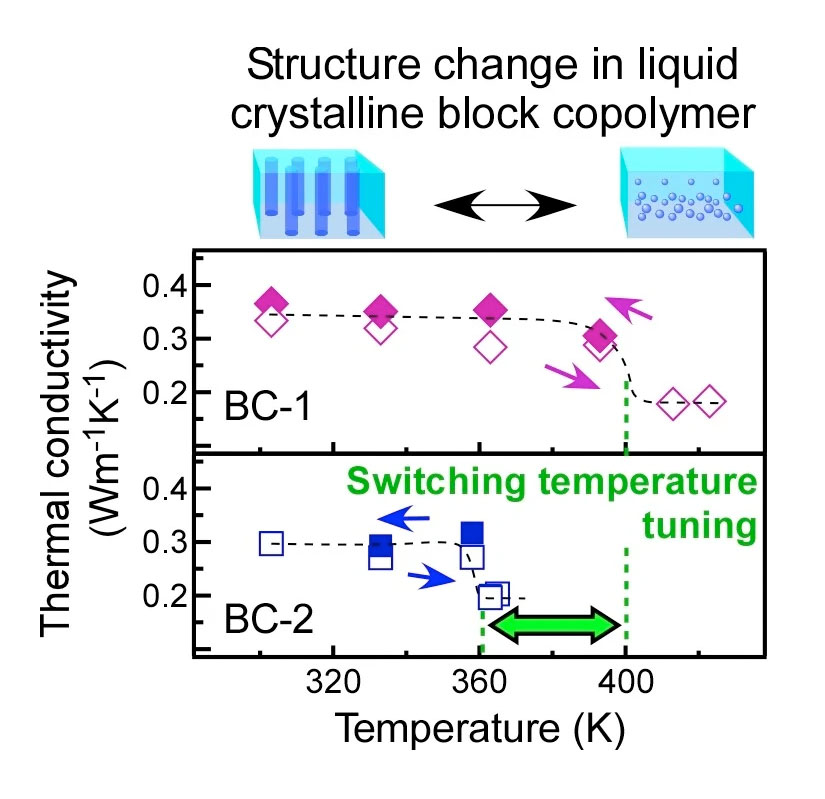| Jul 27, 2022 |
Some don't like it hot: Thermal conductivity-switching bottleneck resolved
(Nanowerk News) Researchers from Osaka University and collaborating partners used straightforward chemical synthesis to modulate the phase transition of a thermal conductivity-switching block copolymer. Reversible changes in the nanostructured anisotropy in the material corresponded to an approximately two-fold change in the thermal conductivity, over the 27°C to 147°C temperature range. These results will enhance the sustainability of upcoming advanced flexible organic electronics.
|
|
Mobile phones from a few decades ago look like antiquated plastic toys today. That's an example of the dramatic miniaturization of modern electronics, as well as added functionality. Unfortunately, this miniaturization comes with a problem: the challenge of dissipating heat. This challenge limits the functionality of ultra-small electronic devices. For practical applications, the solution to heat dissipation must incorporate a means of modulating the temperature at which the device changes its speed of heat transmission.
|
|
Now, in a study recently published in Nano Letters ("Tunable thermal switch via order-order transition in liquid crystalline block copolymer"), researchers from Osaka University and collaborating partners have experimentally modulated the thermal switching temperature of block copolymers. This study will help researchers cheaply modulate the temperature of organic electronic devices by changing the speed of the heat transmission, and thus help solve an important challenge of device miniaturization.
|
 |
| Temperature dependence of thermal conductivity in two kinds of liquid crystalline block copolymer (BC-1, BC-2), where structures of liquid crystalline parts are different. (Image: Yoshiaki Nakamura et al.)
|
|
"Liquid-crystalline, nanostructured block copolymers are ideal for our work," explains first author Takafumi Ishibe. "By using changes in temperature to modulate the anisotropy of the nanostructures, one can easily modulate the thermal conductivity of the polymer."
|
|
One component – known as the mesogen – of the polymer undergoes a phase transition (from cylindrical to spherical nanostructuring) upon crossing a temperature threshold. This temperature is known as the transition temperature. In other words, the anisotropy – and thus the thermal conductivity – of the polymer depends on the temperature.
|
|
The key to the researchers' work is that tuning the chemical composition of the mesogen is an easy means of changing the transition temperature. That is, by straightforward chemical synthesis, one can easily adjust the temperature at which the anisotropy changes occur, and thus change the speed of heat transmission from the polymer.
|
|
"We adjusted the transition temperature over the range of 90°C to 147°C by judicious choice of the mesogen," says senior author Yoshiaki Nakamura. "Conductivity-switching was fully reversible, and the difference between the on and off state was approximately 2, which is comparable to the conventional values of various thermal switch reported in the preceding studies."
|
|
Many researchers have changed the on/off ratio of thermal conductivity-switching materials. However, this study is the first to experimentally focus on modulating the thermal switching temperature by controlling the transition temperature of such materials. By doing so, Nakamura and coworkers have imparted practical functionality to block copolymers that undergo thermal conductivity-switching, and at low cost. This innovation holds great promise for the sustainability of thermal management in upcoming advanced technologies.
|

